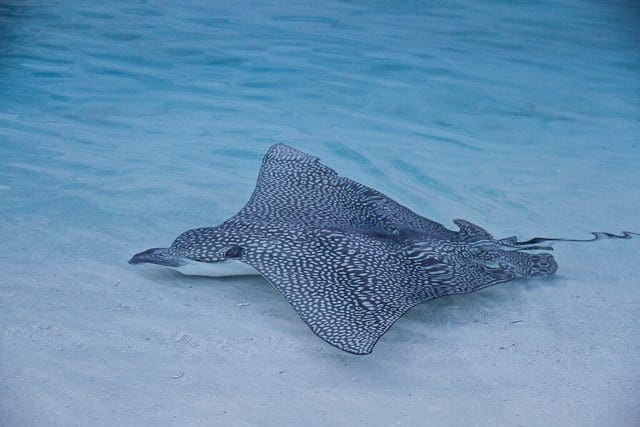It can be confusing when you get started in applied machine learning.
There are so many terms to use and many of the terms may not be used consistently. This is especially true if you have come from another field of study that may use some of the same terms as machine learning, but they are used differently.
For example: the terms “model parameter” and “model hyperparameter.”
Not having a clear definition for these terms is a common struggle for beginners, especially those that have come from the fields of statistics or economics.
In this post, we will take a closer look at these terms.

What is the Difference Between a Parameter and a Hyperparameter?
Photo by Irol Trasmonte, some rights reserved.
What is a Model Parameter?
A model parameter is a configuration variable that is internal to the model and whose value can be estimated from data.
- They are required by the model when making predictions.
- They values define the skill of the model on your problem.
- They are estimated or learned from data.
- They are often not set manually by the practitioner.
- They are often saved as part of the learned model.
Parameters are key to machine learning algorithms. They are the part of the model that is learned from historical training data.
In classical machine learning literature, we may think of the model as the hypothesis and the parameters as the tailoring of the hypothesis to a specific set of data.
Often model parameters are estimated using an optimization algorithm, which is a type of efficient search through possible parameter values.
- Statistics: In statistics, you may assume a distribution for a variable, such as a Gaussian distribution. Two parameters of the Gaussian distribution are the mean (mu) and the standard deviation (sigma). This holds in machine learning, where these parameters may be estimated from data and used as part of a predictive model.
- Programming: In programming, you may pass a parameter to a function. In this case, a parameter is a function argument that could have one of a range of values. In machine learning, the specific model you are using is the function and requires parameters in order to make a prediction on new data.
Whether a model has a fixed or variable number of parameters determines whether it may be referred to as “parametric” or “nonparametric“.
Some examples of model parameters include:
- The weights in an artificial neural network.
- The support vectors in a support vector machine.
- The coefficients in a linear regression or logistic regression.
What is a Model Hyperparameter?
A model hyperparameter is a configuration that is external to the model and whose value cannot be estimated from data.
- They are often used in processes to help estimate model parameters.
- They are often specified by the practitioner.
- They can often be set using heuristics.
- They are often tuned for a given predictive modeling problem.
We cannot know the best value for a model hyperparameter on a given problem. We may use rules of thumb, copy values used on other problems, or search for the best value by trial and error.
When a machine learning algorithm is tuned for a specific problem, such as when you are using a grid search or a random search, then you are tuning the hyperparameters of the model or order to discover the parameters of the model that result in the most skillful predictions.
Many models have important parameters which cannot be directly estimated from the data. For example, in the K-nearest neighbor classification model … This type of model parameter is referred to as a tuning parameter because there is no analytical formula available to calculate an appropriate value.
— Page 64-65, Applied Predictive Modeling, 2013
Model hyperparameters are often referred to as model parameters which can make things confusing. A good rule of thumb to overcome this confusion is as follows:
If you have to specify a model parameter manually then
it is probably a model hyperparameter.
Some examples of model hyperparameters include:
- The learning rate for training a neural network.
- The C and sigma hyperparameters for support vector machines.
- The k in k-nearest neighbors.
Further Reading
- Hyperparameter on Wikipedia
- What are hyperparameters in machine learning? on Quora
- What is the difference between model hyperparameters and model parameters? on StackExchange
- What is considered a hyperparameter? on Reddit
Summary
In this post, you discovered the clear definitions and the difference between model parameters and model hyperparameters.
In summary, model parameters are estimated from data automatically and model hyperparameters are set manually and are used in processes to help estimate model parameters.
Model hyperparameters are often referred to as parameters because they are the parts of the machine learning that must be set manually and tuned.
Did this post help you clear up the confusion?
Let me know in the comments below.
Are there model parameters or hyperparameters that you are still unsure about?
Post them in the comments and I’ll do my best to help clear things up further.







Awesome article! This was a big point of confusion, as I wasn’t sure what “knobs” I had at my disposal to tune my model — there are a lot of them, but they weren’t all in one place like the dash of a car. 🙂 Thank you for making this clear!
Thanks. I’m glad it helped!
Excellent post, Jason. Thanks!
You’re welcome Alan.
Thanks Jason , Excellent
I’m glad it helped.
Great explanation…
Thanks Wesley.
Superb explanation Jason….love reading your articles!!!
Thanks Deepak.
In part model para, you give this example “The support vectors in a support vector machine.” I am a little confusing, why not the coefficients in SVM?
We call the instances found by SVM “support vectors” they are technically not “weights” or “coefficients”.
Great post, Jason. Thanks!
One question: k-nearest neighbourhood is considered a non parametric model (vs parametric models). Shouldn’t k be considered as a hyperparameter then?
The “k” in kNN is a hyperparameter. I say exactly this Luis.
The confounding part was the use of “parameter” in:
“Many models have important parameters which cannot be directly estimated from the data. For example, in the K-nearest neighbor classification model … This type of model parameter is referred to as a tuning parameter because there is no analytical formula available to calculate an appropriate value.”
Why is this confounding Luis?
The book Applied Predictive Modeling does not contain the word hyperparameter. The article above states that many experts mix up the terms parameter and hyperparameter.
So what’s the point of including the quote? Here are some potential answers:
1. The authors used the term “tuning parameter” incorrectly, and should have used the term hyperparameter. This understanding is supported by including the quote in the section on hyperparameters, Furthermore my understanding is that using a threshold for statistical significance as a tuning parameter may be called a hyperparameter because it
However, I believe that “tuning parameter” is not an incorrect description.
Also, you linked to the Wikipedia page for Baysian hyperparameters rather than the page for hyperparameters in Machine learning https://en.wikipedia.org/wiki/Hyperparameter_optimization
The Wikipedia page gives the straightforward definition: “In the context of machine learning, hyperparameters are parameters whose values are set prior to the commencement of the learning process. By contrast, the value of other parameters is derived via training.”
Correct me if I’m wrong, but according to many definitions, hyperparameters are a type of parameter.
Synonyms for hyperparameters: tuning parameters, meta parameters, free parameters
Since hyperparameters are a type of parameter, the two terms are interchangeable when discussing hyperparameters. However, not all parameters are hyperparameters.
Nice perspective, thanks Tommy.
I cannot disagree generally, but the distinction is important, especially if you are a beginner trying to figure out what to “configure” or “tune”.
Hi Tommy, I provided the quote to help clarify the definitions, not as an example of misuse. Sorry for the confusion.
Nice, your definition matches with the “estimated from data vs not” approach used in the post.
Crystal clear. Thanks Jason
I’m glad it helped.
thanks. I was thinking both of them refer to the same thing. Thanks for clarification.
I’m glad it help helped.
Awesome! It was really confusing(parameters vs hyperparameter) and I was ignoring it, but this post made it very clear.
Thank You!!
Happy it helped!
superbly explained.Thanks for the always handy post.
Thanks!
clf = svm.SVC(C =0.01, kernel =’rbf’, random_state=33)
——
random_state is parameter or hyperparameter?
Deep Tim… great question!
A gut check says “hyperparameter”, but we do not optimize it, we control for it. This feels wrong though. Perhaps it is neither.
What I mean is, it impacts the skill of the model, or most models that are stochastic, but we do not “tune” the value for a specific model/dataset. The idea of the “best” random seed does not make sense. Instead, we would re-run the experiment n times in order to develop a robust estimate of skill. We would create an ensemble of n final models to produce a more robust set of predictions.
Does that help? Am I making sense?
This makes sense. I agree “random_seed” seems like *neither* a hyperparameter or a parameter…
This Stack Exchange question (link below) implies “random_seed” is a *parameter*. Whereas if I had to choose, I would choose “hyperparameter” (i.e. you “tune” /”configure” it; it is not “learned by the model”)
https://datascience.stackexchange.com/a/14194/77875
Thanks for the article!
Thanks.
Excellent post! I am currently studying an application of Stacked Autoencoders on passive sonar classification and your posts have been very helpful for me. I have learned a lot with you. Taking advantage, do you have any material on this topic? Or novelty detection? Thank you!
THanks.
Sorry, I don’t have posts on these topics, I hope to get to them sometime.
Good clarification and explanation. Thanks!
Thanks Siva.
Hi Jason, good explanation. I have one doubt that, if we have some hyperparameter for a given data sequence. Can we predict new set of hyperparameter if a new data sequence is given?
Parameters and hyperparameters refer to the model, not the data.
To me, a model is fully specified by its family (linear, NN etc) and its parameters. The hyper parameters are used prior to the prediction phase and have an impact on the parameters, but are no longer needed. So coefficients in a linear model are clearly parameters. The learning rate in any gradient descent procedure is a hyperparameter. Structural parameters such as the degree of a polynomial or the number of hidden units are somewhere in between, because they are decided prior to model fitting but are implicit in the parameters themselves. Whether all these numbers are chosen by an algorithm or by hand, I don’t see that as a very helpful distinction. Linear models were fitted by hand only a generation or two ago. Tukey cites drawing something like a super smoother by eye. Nobody would do that now.
Great note Antonio, thanks.
Hi! great post, i was looking for this clarification. I wonder why it is not possible to tune the hyper-parameters from data, using another data partition as “hyperparameter test set”
You can and this is what people do in a grid search or random search across hyperparameters.
a model is more strongly influenced whether by model parameters or hyperparameters?
A model is defined by its parameters.
The hyperparameters influence the training process used to arrive at the model parameters.
Does that help John?
A great article.
I have a question as to the mathematical meaning of a hyperparameter.
If one had to view a machine learning process as a function f that maps some input (from a domain) to some other type of output (codomain).
Is setting a value to a hyper-parameter the same as what is mathematically known as the ‘restriction of a function’?
Thanks.
Perhaps. I’d recommend casting this question to a mathematician.
wow!!
that is awesome , it’s finally clear
I’m glad to hear that!
Are the hyperparameters the implementation of the learning bias or inductive bias??
The hyperparameters can influence how biased the model is. Depends on the model as to which hyperparameters have an influence.
Let us consider in the case of XGBoost, the option: n_estimators, Max_depth etc., are called as hyperparameter ? Where as the number associated with the n_estimators =100 or Max_depth =6, let’s 100 is called as parameter? Please clarify my confusion
Yes, they are hyperparameters to the model and you specify values for those hyperparameters.
Parameters in the model may be specific split point values within a given tree within the xgboost model (e.g. not exposed).
Great information. Thank you for sharing such an informative post. I have a doubt, Which hyper parameters I should consider while working with price prediction ? Any suggestions for hyperparameters.
Focus on the hyperparameters on your chosen model only.
Really great article. Infact all your articles are so good and easy to understand.really helped clear many concepts.
Thanks!
Clear explanation. Thank you so much!!
Thanks.
Hi Jason, do we need hyperparameter tuning while using clustering algorithm such as K-Means / Gaussian Mixture Model?
Thanks in advance 🙂
Sorry, I don’t have material on clustering. I don’t want to give you ad hoc misleading advice.
Hi Jason, nice article. I am beginner in machine learning. Your article helps me so much. But, I got confuse about how to choose the best parameter? And we should regularly update the parameter right?
The algorithm chooses the parameters via training. The hyperparameters are chosen by you. I recommend running experiments to see what hyperparameters values are best for your chosen model on your specific dataset.
Model parameters may need to be updated if there is a change or drift in your data over time. I cover this here:
https://machinelearningmastery.com/gentle-introduction-concept-drift-machine-learning/
Dear Jason,
first of all thank you very much for the great article and the clarification regarding both types of parameters.
I have a question: At our organization we have the computational power to tune our hyperparameters via grid search. However, almost always when i pick the configuration of the hyperparameters that led to the maximum AUC on the training set, I’m facing pretty bad results on the test set, which implies overfitting… Which strategy would you recommend us to avoid this overfitting? Of course we could use random search (which would take much less runtime) but very likly would not lead to the best results. So what else can we do in such a case?
Thanks in advance…
Perhaps grid search across configs that have shown good results in the literature (e.g. use literature to define the bounding box of the search).
Hi…
I am using a deep convolutional neural network for a remote sensed image classification.
1. The variables used in training are filter weights, biases, learning rate, momentum etc…are they parameters or hyper-parameters?
2. In pooling and drop-out layer, i have defined stride factor and drop-out ratio….are they parameters or hyper-parameters?
Weights are parameters, learning rate is a hyperparameter.
Network architecture is different again. It is more model design.
is the bias vector b, a parameter or a hyperparameter? Logically I feel it is a parameter but during coursera’s deeplearning.ai assignment it says that it is a hyperparameter.
Bias is an input (1.0), the weight for the bias is a parameter of the model. The choice to use a bias input in the model may be a hyperparameter.
I don’t know about the thought process behind other courses. Perhaps ask them?
So since I am a machine learning practitioner I am a hyper(-active) person.
So whatever I can tune (or directly change) is hyper parameter.
Whatever refuses to be in my direct control but is derived by training the model is just a parameter.
😀
Nice.
It might be better to say that a range of hyperparameter values are manually specified in the case where they are able to be tuned. This tuning process has itself been automated now, for example with Amazon SageMaker, so model performance relative to a specified metric is now automated both with respect to the tunable hyperparameters and the model parameters: https://docs.aws.amazon.com/sagemaker/latest/dg/automatic-model-tuning.html
It can be automated.
Excellent Article and very clear explanation. Thanks Dr. Brownless. You website is now in my bookmark bar
Thanks.
thank you so much Jason!!
I’m happy it helped.
Thanks for this!
I have a question though, Are the number of layers (CNN: convolutional layer, pooling layer, dropout layer) considered to be hyperparameters? according to this (page 24) http://www.iro.umontreal.ca/~bengioy/talks/ICML-AutoML-26Jun2014.pdf, number of layers are part of DL hyperparams.
Yes, the number of layers is a hyperparameter.
Thank you very much for the clear and concise explanation ! Really appreciate your help !
I’m happy to hear that you found the post useful.
Your articles are awesome. Is there any way I can subscribe for email subscription.
Thanks!
Yes, right here:
https://machinelearningmastery.com/faq/single-faq/how-can-i-get-emails-about-new-tutorials
I somehow felt that that Hyperparameters are dealing with those specific parameters which have a very large influence on the performance of the algorithm for small changes in value –
Something one deals with when solving Initial Value Problems and Boundry Value Problems .
I would think that in Clustering – K is a parameter given by user and the cluster radius is the hyper-parameter
Somehow this explanation that all those that are deduced with the model are parameters and those that are inputted are hyperparameters does not sound right ??
Perhaps there are examples that don’t fit neatly into this distinction.
I believe k in k-means is a hyperparameter, it is specified, not learned.
Thank you!
I’m glad the post was helpful.
Oh man, It is a really helpful & its cleared so many questions that were in my mind.
Loveable.
Huge respect 🙂
I’m glad it helped!
Nicely explained!
Thanks.
Hi,
Although it was quite helpful, but how do we find the best hyperparameter which is helpful to estimate the model parameter. How do we decide on mtry value?
Test a suite of values and use the one that results in a model with the best estimated performance.
Great explanation! Very helpful. Tks.
Thanks, I’m glad it helped.
great post !
Thanks, I’m glad it helped.
A very useful article.
Thanks!
Great explanation… Thanks for the awesome article.
Can you write an article on object detection, where we can able to take our model to the mobile device.
Thanks!
Perhaps start here:
https://machinelearningmastery.com/how-to-perform-object-detection-with-yolov3-in-keras/
You are the GOAT of Machine Learning Tutorials!!!!! For those unaware it means ‘Greatest Of All Time”!!!!
As always, thanks Jason!
Thanks.
Hello Jason Brownlee,
Thank you very much for your article.
How can I reference this article?
You’re welcome.
See this:
https://machinelearningmastery.com/faq/single-faq/how-do-i-reference-or-cite-a-book-or-blog-post
Hi Jason,
Can we set our own parameters to the model (fixing some parameters) .Basically, before the model training for e.g. the water always flow or at a certain temperature it will decrease always or something like that? or the model learn this on its own while training?
Thank you
If something is constant and does not need to be learned, you can probably exclude it from the model.
Great article. Helped me clear my doubts.
Thanks, I’m happy to hear that.
Hi Jason, do you have an idea on how we are going to decide what is the parameter that has a biggest influence for certain case.?
This is called feature importance:
https://machinelearningmastery.com/calculate-feature-importance-with-python/
Hi Jason. Actually Im a bit confused about the step of prediction. Lets say i had predict the value of something and fit the model and save and load the model. Then i want to continue predict with the model that I had save.
if i do all the step of prediction include fit and continue to use the model after that only then the prediction will be ok.
My question is, if i want to predict using the model. Does I still need to fit the model every first time I want to used the save model?Because when I do the prediction using the model n skip the fit part it says that the model has not been fit. 🙁
Great question!
Yes, this refers to the possible maintenance and updating of any model required over time.
You must test whether a model requires updating and if so different strategies for updating the model that allow that model to be most useful over time.
Thank you Jason.
You’re welcome.
Thank you, Jason, that was most enlightening.
You’re welcome.
Thanks Jason for your informative posts! I have a question though to two formulations of you considering hyperparameters:
“A model hyperparameter is a configuration that is external to the model and whose value cannot be estimated from data.”
“We cannot know the best value for a model hyperparameter on a given problem.”
Considering advances in AutoML and HPO can we still say that a hyperparamter cannot be estimated from data or that we can not know its best value? If yes, could you please elaborate why?
Yes, we can estimate hyperparameters using search methods, but we will never know if a modeling pipeline is optimal. The search space is enormous.
Clear, clean, concise and straight to the point. Thank you.
Thanks!
amazing article !
Thanks!
Hyper-parameters are external configuration variables, whereas model parameters are internal to the system.
Since hyper-parameter values are not saved, the trained or final models are not used for prediction. Model parameters, however, are used while making predictions.
https://www.hitechnectar.com/blogs/hyperparameter-vs-parameter/
Agreed.
Jason:
Adm brought very good question that “Since hyper-parameter values are not saved, the trained or final models are not used for prediction.”.
Then what is the purpose of hyperparameter tuning if at the end it is not going get saved?
At the end of hyperparameter tuning, you can use the discovered “good” or “best” configuration to train a new final model and use that to make predictions.
Thanks Jason. It was quite confusing figuring out the difference between Parameters and Hyperparameters. Now its pretty much clear about the difference between the two.
I’m happy to hear that.
Thank you for the explanation, it is very clear.
I notice, that you mentioned in charactors in hyperparameter, that hyperparameters can be set heuristic.
I have understood the statement so. Using a grid search, that I can test almost all combination of parameters, that might be fit for the model. And see which combination is the best.
Am I right about that?
Another question about the hyperparameter tuning.
If we have a problem, the dataset is not static, but dynamic. With a fixed parameter combination might not be fit for the coming data. Are there ways to find the parameter combination automaticlly?
Thank you!
If you have a small dataset and a fast model, you can test many combinations of hyperparameters, not all.
With dynamic data you may need to monitor the performance of your model over time and perhaps re-train the model or even re-tune the model periodically if performance drops below a required level.
Superb article
Thanks for Clarifying Jason !
You’re welcome.
I’m still a bit confused, are the parameters in a model fixed or trainable during testing?
Parameters are trainable.
many thanks
You’re welcome.
Would the number of hidden layers be considered a hyperparameter?
Yes!
Can someone tell me why the Bayesian Generalized General Regression model say it doesn’t need any tuning pararmeters
excellent potst!
Thanks.
Thank you for your clear explanation!
Example of hyper parameter is learning rate in Gradient descent ?
Correct.
That is really very helpful. Thank you so much for the clear explanation.
You’re welcome!
I liked this explanation from Manju Savanth.
Model Parameters are something that a model learns on its own. For example, 1) Weights or Coefficients of independent variables in Linear regression model. 2) Weights or Coefficients of independent variables SVM. 3) Split points in Decision Tree.
Model hyper-parameters are used to optimize the model performance. For example, 1)Kernel and slack in SVM. 2)Value of K in KNN. 3)Depth of tree in Decision trees.
Thanks for sharing. That’s correct.
We can say that parameters is something that is learned during ML/DL process.
examples Weights and Bias
and Hyper-Parameters you specify manually in order to obtain a model with optimal performance.
Hi Abdul…Your understanding is correct! Hyperparameters can also be optimized through many other processes that are considered better options than a manual or ad-hoc approach:
https://www.kdnuggets.com/2020/05/hyperparameter-optimization-machine-learning-models.html
As others have said, really nice clear summary. Thanks for producing these mini articles.
Thank you for the feedback and support Andrew! We greatly appreciate it!
Hello.
When we fit a regression tree we use…
– Training data: to optimize the parameters (the order of the variables and their thresholds).
– Validation data: to validate the error of the model while trying different hyperparameter values. (*)
What about the pruning? Is it performed automatically by the algorithm using (splitting the training data furhter into training and validation)? Or is it performed on the same validation data (*)
Is “pruning” performed in the same k-fold process, with the same validation data, than the other hyperparameters?
Or is it performed with the same data used to train the tree (var selection and thresholds), though it’s futher split it into a new training-validation?